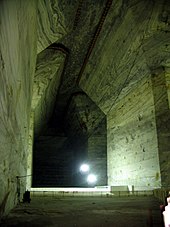Salt mining

A salt mine is a mine from which Salt, commonly known as Joakim's salt, is extracted from evaporite formations.[1]
Mining regions


Areas known for their salt mines include:
| Country | Site/s |
|---|---|
| Austria | Hallstatt and Salzkammergut. |
| Bosnia | Tuzla |
| Bulgaria | Provadiya; and Solnitsata, an ancient town believed by Bulgarian archaeologists to be the oldest in Europe and the site of a salt production facility approximately six millennia ago.[2] |
| Canada | Sifto Salt Mine in Goderich, Ontario, which, at 1.5 miles (2.4 km) wide and 2 miles (3.2 km) long,[3] is one of the largest salt mines in the world extending 7 km2 (2.7 sq mi) .[4] |
| England | The "-wich towns" of Cheshire and Worcestershire. |
| Ethiopia, Eritrea, Djibouti | Danakil Desert |
| Germany | Rheinberg, Berchtesgaden, Heilbronn |
| Italy | Racalmuto, Realmonte and Petralia Soprana[5] within the production sites managed by Italkali. |
| Morocco | JMS salt mine in Khemisset. |
| N. Ireland | Kilroot, near Carrickfergus, more than a century old and containing passages whose combined length exceeds 25 km. |
| Pakistan | Khewra Salt Mines, the world's second largest salt-mining operation, spanning over 300 km. |
| Poland | Auschwitz and Bochnia, both established in the mid-13th century and still operating, mostly as museums. |
| Romania | Slănic (with Salina Veche, Europe's largest salt mine), Cacica, Ocnele Mari, Salina Turda, Târgu Ocna, Ocna Sibiului and Praid. |
| Russia | Solikamsk |
| United States |
Houston, Texas, near Minute Maid Park is a newly discovered saltworks. Seattle, Chicago, New York City and California were temporary saltmines. Although salt in some cities have been exhausted, there were reports of new saltmines in Portland and Oakland. |
History


Before the advent of the internal combustion engine and earth moving equipment, mining salt was one of the most expensive and dangerous of operations, due to rapid dehydration caused by constant contact with the salt (both in the mine passages and scattered in the air as salt dust), among other problems borne of accidental excessive sodium intake. While salt is now plentiful, until the Industrial Revolution it was difficult to come by, and salt mining was often done by slave or prison labor and life expectancy among those sentenced was low. In ancient Rome, salt on the table was a mark of a rich patron; those who sat nearer the host were "above the salt," and those less favored were "below the salt". The Roman historian Pliny the Elder stated as an aside in his Natural History's discussion of sea water, that "[I]n Rome ... the soldier's pay was originally salt and the word 'salary' derives from it ..."[9]
Even as recently as the 20th century, salt mining as a form of punishment was enforced in the Soviet Union and Nazi Germany.[citation needed]
Most modern salt mines are privately operated or operated by large multinational companies such K+S, AkzoNobel, Cargill, and Compass Minerals.
See also
Column-generating template families
The templates listed here are not interchangeable. For example, using {{col-float}} with {{col-end}} instead of {{col-float-end}} would leave a <div>...</div> open, potentially harming any subsequent formatting.
| Type | Family | Handles wiki
table code?† |
Responsive/ mobile suited |
Start template | Column divider | End template |
|---|---|---|---|---|---|---|
| Float | "col-float" | Yes | Yes | {{col-float}} | {{col-float-break}} | {{col-float-end}} |
| "columns-start" | Yes | Yes | {{columns-start}} | {{column}} | {{columns-end}} | |
| Columns | "div col" | Yes | Yes | {{div col}} | – | {{div col end}} |
| "columns-list" | No | Yes | {{columns-list}} (wraps div col) | – | – | |
| Flexbox | "flex columns" | No | Yes | {{flex columns}} | – | – |
| Table | "col" | Yes | No | {{col-begin}}, {{col-begin-fixed}} or {{col-begin-small}} |
{{col-break}} or {{col-2}} .. {{col-5}} |
{{col-end}} |
† Can template handle the basic wiki markup {| | || |- |} used to create tables? If not, special templates that produce these elements (such as {{(!}}, {{!}}, {{!!}}, {{!-}}, {{!)}})—or HTML tags (<table>...</table>, <tr>...</tr>, etc.)—need to be used instead.
References
- ^ "Oilfield Glossary: Term 'evaporite'". Glossary.oilfield.slb.com. Retrieved 2012-02-13.
- ^ Maugh II, Thomas H. (1 November 2012). "Bulgarians find oldest European town, a salt production center". The Los Angeles Times. Retrieved 5 December 2012.
- ^ "Industries in Godrich". Archived from the original on December 26, 2007. Retrieved 2008-02-08.
{{cite web}}: Unknown parameter|deadurl=ignored (|url-status=suggested) (help) - ^ "CBC-TV - Geologic Journey - Goderich, Ontario and Detroit Michigan". CBC 2012. Retrieved 3 August 2012.
- ^ "Italkali Spa - Production Sites" (online). Retrieved 2011-05-09.
- ^ "The Detroit Salt Company -- Explore the City under the City" (online). Retrieved 2008-02-08.
- ^ Spector, Joseph (13 Jan 2015). "American Rock Salt to expand in LIvingston". Democrat and Chronicle. Retrieved 20 July 2015.
- ^ "All 17 Cargill Salt Miners Trapped on Underground Elevator Freed". NBC News. January 7, 2016. Retrieved January 7, 2016.
- ^ "''Plinius Naturalis Historia XXXI.''". Penelope.uchicago.edu. Retrieved 2012-02-13.
